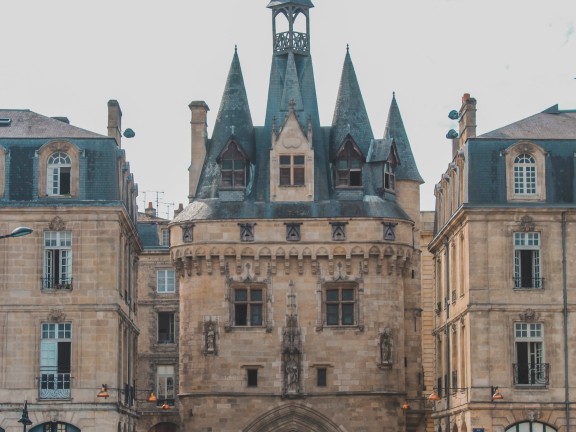Bordeaux, France: A Model of Sustainable Infrastructure and Cultural Preservation

Variations in infrastructure are often what make cities around the globe unique and memorable. Take Bordeaux, France, an important port city in the southwest of France, as an example. It is home to the Place de la Bourse, a beautifully expansive building right on the Garonne River, a short distance from the Pont de Pierre, a historic bridge from the Napoleon era. These sights are not found anywhere else in the world, and Bordeaux’s enticing museums and landscapes are only one part of what makes this city so important.
The architecture is stunning, as Bordeaux is a World Heritage City (WHC) and has particular emphasis on infrastructure. This focus makes the city a strong candidate to exemplify SDG #9: Industry, Innovation, and Infrastructure.
According to the Organization of World Heritage Cities (OWHC), Bordeaux displays an “exceptional urban and architectural transformation that continued through the 19th century up to the present time.” The steadfast commitment to revitalizing its infrastructure has boosted tourism and is promising for the city’s future, ultimately building a culture of forward-thinking innovation that exemplifies some efforts that are necessary to achieve SDG9 and maintain that status.
UNESCO also credits Bordeaux’s infrastructure, stating how the city has “more protected buildings than any other French city except Paris.” Protecting buildings is integral to preserving history and cultural heritage, as well as a testament to the integrity of the infrastructure of the country. The Place de la Bourse was built almost 300 years ago and encapsulates the architectural Golden Age of Bordeaux, as it was the first building completed during that era. In addition, surrounding buildings such as the Grand Théâtre and the Cours du Chapeau contribute to Bordeaux having one of the most renowned 18th century architectural ensembles in all of Europe. These buildings will continue to commemorate the history of Bordeaux and highlight its unique architectural development.
As a port city, Bordeaux has a rich history in the port industry and it became prosperous due to trade. The connection of people at the city also made it a place for the exchange of different cultural ideas, which continues today and contributes to the city’s individual identity. This demonstrates the relation between the protection of history with the ability to educate and connect people from around the world, which is what World Heritage Cities and GPA aim to do. In a unique connection to Philadelphia, tradesman and philanthropist Stephen Girard was born in Bordeaux, traded between Bordeaux and Philadelphia, and eventually established Girard College in Philadelphia.
In addition to Bordeaux, France as a whole has demonstrated an admirable commitment to centering the national conversation around sustainable development as the effects of climate change are felt around the globe. The country has encouraged French citizens to prioritize sustainable living, which is now a common cultural value. Personal property is under strict regulations in the name of sustainability; individual properties for sale are given sustainability grades and if they fall below a certain score, sellers may need to renegotiate prices or make changes like fixing windows, insulation, or addressing their water supply. Similarly, car fuel efficiency and emissions are graded and may even affect citizens’ ability to travel into Paris if their cars fail to meet the standards.
GPA’s Communications Coordinator and EIJP Editor, Jessica Barber, is currently a French resident with specific insight into France’s SDG initiatives. In Jessica’s personal experience, France “is on the other side of the spectrum from what the United States is doing” in terms of sustainable development. Free, quality education is the norm. Energy conservation and accessibility to affordable, clean energy and healthy, quality food are major priorities. Jessica further explained how the transit systems are robust, accessible, and highly encouraged to citizens, which connects to SDG13: Climate Action, SDG12: Responsible Consumption and Production, and most of all, SDG9: Industry, Innovation, and Infrastructure.
Bordeaux is a city that centers sustainability and cultural and historical heritage preservation; one example in a country that recognizes the link between sustainable development and a prosperous future. By highlighting other countries and World Heritage Cities (WHCs) around the world, GPA hopes to educate the public on global initiatives and strategies that can potentially be implemented or reflected here in the United States, particularly in Philadelphia. In the recent 78th General UN Assembly, world leaders reaffirmed their devotion to achieving SDGs through a political declaration. The United States still has significant strides to make in this initiative.
As one of the few World Heritage Cities in the United States, Philadelphia aims to be a progressive example of sustainable development, as Bordeaux is in France. Philadelphia’s preservation of history and cultural heritage is unique; no other city is the home to Independence Hall, a recognized World Heritage Site, nor to lesser globally-recognized historical landmarks like the Edgar Allen Poe National Historic Site or the Philadelphia Masonic Temple.
Yet, Philly still has work to do in achieving equity and sustainability. In regards to SDG9, Philadelphians can promote the protection and recognition of historic buildings and encourage use of public transportation. Other areas that are necessary to address, such as access to healthy food options, poverty rates, and the cost of education and healthcare, serve as reminders of the progress that Philadelphia can make and what it can learn from other world heritage cities abroad. The city will be more global, liveable, and inclusive if these goals are put at the forefront of the government and the public’s minds.
